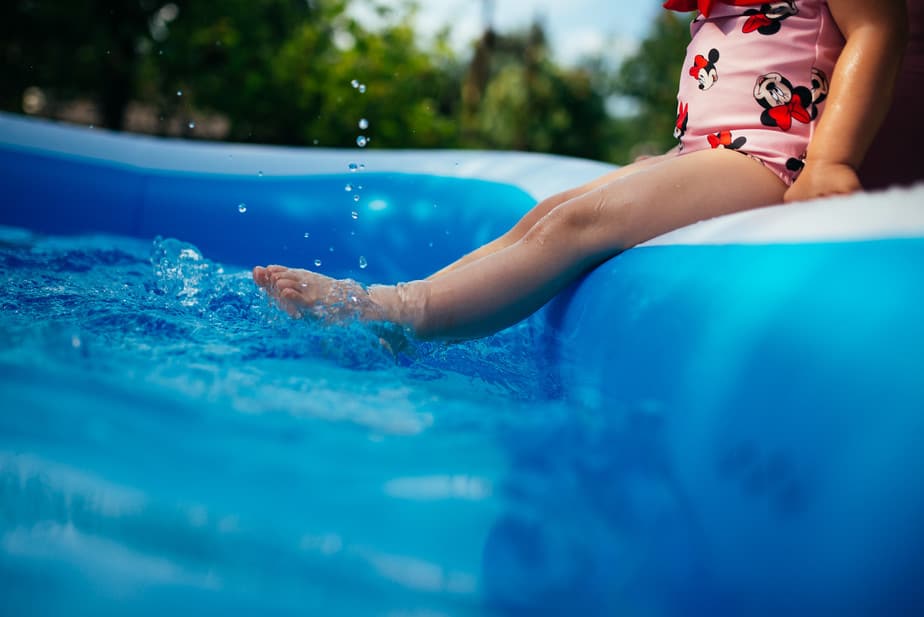As summer transitions to fall and eventually winter, the weather starts getting noticeably colder until it’s time to put away that inflatable pool that is seeing less and less use. If you want to use it again next summer, you have to put it away properly, otherwise you might not have a pool to use next summer!
We know, taking down the pool is not as enjoyable as setting up the pool, but it’s still an important job so that the inflatable pool does not suffer any damage due to neglect. You will use it again soon enough.
If you’re a first time pool owner and this is the first time you are putting it away, you might be wondering how to store an inflatable pool for the winter. The process involves first draining the pool, cleaning it, and then ways you can store the pool, such as in a large bin, storage tote boxes, a storage unit, or even just leaving it outside if the winters are not so cold where you live.
In this article, we will be going over in more detail how you can do each of the above so that your inflatable pool can remain in good condition for the next season.
Why do you need to store an inflatable pool?
Depending on your circumstances, you don’t strictly need to store the inflatable pool somewhere. That said, if you don’t plan on using it, leaving it exposed to the elements and pests is just an invitation to more problems.
First off, if the winters do get cold enough, then the harsh cold could easily damage your pool. Furthermore, a pool will end up catching a bunch of airborne debris like leaves and branches. You also don’t want your pool to become home to pests and other creatures. Who knows what they are thinking.
The good thing is that you can easily prevent all of this by having the right equipment and, of course, knowing how to store your inflatable pool properly.
Preparation
Drain and dry the pool
First things first, before storing the pool you need to first get rid of all the water inside. Completely drain it so that there aren’t any pools of water trapped inside. Stagnant water is a fertile breeding ground for bacteria, fungi, and insects, so this is a major concern.
Failure to completely drain all of the water from the pool before storing it will result in a mold and mildew surprise when you inflate it next summer.
The general recommendation is to drain your inflatable pool using a pump, then leave it out in the sun for a few days for the remaining pools of water to completely air dry.
If you don’t have much time, you can dry the pool by hand after draining it. Wipe off the excess water using a sponge or mob, then dry the remaining droplets of water using a towel, paper towels, or even a rag.
Sterilize and disinfect the pool
After drying the pool, it almost seems like you’re done; just pack it up and put it away, right? Unfortunately, no. Drying the pool just gets rid of the environment for bacteria to thrive in, but there are still bacteria lingering on the inflatable pool. For good measure, you should also disinfect the pool before storing it.
You can use bleach solution or even just dish soap to get rid of the remaining germs and bacteria. Spray your preferred cleaning solution onto the pool and scrub it thoroughly with a rag.
If you want a more environmentally-friendly solution, you can spray vinegar onto the pool surface instead. It’s not as effective, but it’s completely natural and gets the job done. There are other green products on the market, if this sort of thing interests you.
After disinfecting the pool, you’ll want to leave it out in the sun to dry again. This will get rid of the water in the disinfectant and ensures that the pool is bone dry before you store it.
Ways to store an inflatable pool
Most inflatable pools are straightforward to store. To briefly summarize this section, you can keep the parts that make up the structure of the pool in containers. Be careful when storing any small parts so that you do not break them nor lose them. Store the smaller parts in a separate container or a plastic bag.
As for the inflatable material, roll it up and flatten it as much as you can to save as much space as you can. Mildew can potentially still grow even after your drying efforts due to condensation, so consider storing the inflatable material in a mesh tote so that it can breathe. Label each piece and store relevant parts close-by for easy assembling next summer.
Use a large trash bin
A very common way for inflatable pool owners to store their pool is by putting it in the trash. No, this is not our snarky way of telling you to throw your pool in the trash; we’re saying to literally use a trash bin as a storage bin.
It’s actually very convenient because trash bins are relatively large, are resistant to the elements, and they come with wheels so you can literally just wheel it in and out as you need. Make sure the lid closes tightly otherwise water and pests might be able to get in.
Obviously, for hygienic reasons, you should get a brand new trash bin that is dedicated to storing your inflatable pool; don’t use old trash bins please.
As an example, you can store a 10 feet by 30 inches Intex inflatable pool inside a 50-gallon trash bin if you can channel your inner Marie Kondo and pack everything neatly and tightly such that it sparks joy.
Now, what do you do about your other pool equipment such as pumps and hoses? You can put them in a secure cabinet or basement if you have one. If you don’t, then let’s move on to our next suggestion.
Use storage tote boxes
Storage tote boxes are another great option to keep your inflatable pool safe during the off-season. They are also a great place to store your other equipment like hoses, pool pump, and chlorine dispenser.
Unlike trash bins which take up a lot of vertical space, storage tote boxes are horizontal and can easily be stacked if you need another one. This makes them a space efficient solution to store your various pool equipment and the inflatable pool itself. The only place it loses out on, when compared to a trash bin, is that it’s not portable.
We also recommend putting a few mothballs inside the boxes to keep pests out. If moths or other pests get inside, they could potentially ruin your pool, defeating the purpose of storing it.
Keep in mind that condensation can form inside the box if you leave it outside or in a moist environment. Dry to put your trash bin or storage tote boxes in a dry location such as a storage room or basement. Unfortunately, sheds and possibly even garages can get cold enough to allow condensation to form.
Also, it’s best to keep these containers in a location where your kids cannot easily reach them, because A) they can topple over and B) you probably don’t want the kids to be opening the boxes and taking things out without supervision.
Put it in a storage unit

Not everyone has spare space in their house to store a bunch of pool equipment. If the thought of having a few storage tote boxes or garbage bins just occupying space around your house doesn’t sit well with you, consider renting out a storage unit.
Whether you should rent a storage unit or not depends on the size of your pool and how much equipment, chemicals, toys, and floaties you have. A small pool with minimal equipment is probably not worth it, but the bigger your pool and the more stuff you have, the more viable this option becomes.
Alternative: just leave it outside
Lastly, depending on where you live, you may be able to simply leave your pool outside. Granted, this option is not viable for everyone, but this is a legitimate option for people living in warmer climates.
Since putting up and taking down your pool each summer can be a tedious job for many pool owners, if the winters are warm enough where you live, you might be able to just leave it outside.
Not every pool can be left outside over the winter; you will need to do some work such as adding the necessary chemicals and covering it up so that it doesn’t get damaged by exposure to the elements. This might sound like a pain in the butt as well, but it may be a more attractive option than completing dismantling and setting up the pool each year.
In order to leave the pool outside, you’ll need the following equipment:
- A pool cover.
- Cable and winch for pool cover.
- A pool pillow.
- Winterizing kit (pH increaser, algaecide, pool shock, alkalinity increaser, and calcium hardness increaser).
- Pool cover clips.
As usual, you will need to remove all of the pool equipment such as the pool ladder, toys, and any other pool accessories. You can store them in a storage tote box or other such container, but don’t leave them in the pool.
Remove all the hoses, pumps, and drain plugs. We recommend storing the drawing plugs in the pump basket so that these pieces that work together can be found together the next time you reopen the pool.
You should also remove the old filter cartridge, drain it and rinse it with fresh water. Leave the valves open and store the cartridge indoors. You might even want to entirely replace the filter cartridge with a new one if the old one is in poor condition. Those with a sand filter should set the multiport valve to “Winterize”, then take out the drain plug below to completely allow it to drain.
We recommend you read our article on how to winterize your Intex pool to get the full details, but the point of this section is to let you know that this is a potentially viable option for you if the weather conditions are not as extreme.
Summary
Storing your inflatable pool properly is not that difficult of a task to do. Once you have the right storage equipment and are armed with the knowledge on how to best clean, disinfect, and store your equipment, the actual doing of the task is quite straightforward.
If you are reading this article, then you are doing your due diligence. Many first time pool owners enthusiastically plow ahead with little to no research, and chances are high that they will regret it. Improper storage of pool equipment can lead to mold and mildew, and pests can get inside and damage your equipment. They are in for a nasty surprise when they open up their storage containers next summer.
By taking the time to get dedicated storage containers for the pool, you can easily store all of the relevant equipment together. Carefully cleaning and then drying out the equipment ensures no mold or mildew will develop. Putting the containers in a cool, dry place out of the sun will further reduce the chances of damage.
Depending on the weather conditions, you might be able to leave an above-ground pool outside for the winter. There are some extra steps you will need to take in order to winterize it. Inflatable pools should not be left outside in the winter. By following these steps, you ensure that your inflatable pool will be in good working condition year after year.
Photo Credit: Ivan Radic (CC BY 2.0)

